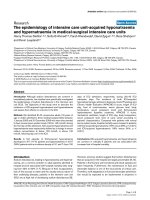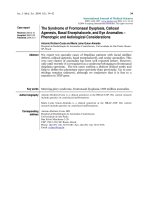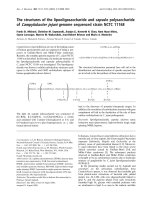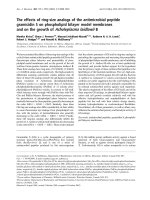Báo cáo y học: "The epidemiology of intensive care unit-acquired hyponatraemia and hypernatraemia in medical-surgical intensive care unit"
Bạn đang xem bản rút gọn của tài liệu. Xem và tải ngay bản đầy đủ của tài liệu tại đây (218.95 KB, 8 trang )
Open Access
Available online />Page 1 of 8
(page number not for citation purposes)
Vol 12 No 6
Research
The epidemiology of intensive care unit-acquired hyponatraemia
and hypernatraemia in medical-surgical intensive care units
Henry Thomas Stelfox
1,2,3
, Sofia B Ahmed
3,4
, Farah Khandwala
5
, David Zygun
1,2,6
, Reza Shahpori
1
and Kevin Laupland
2,1
1
Department of Critical Care Medicine, University of Calgary, Foothills Medical Centre, EG23, 1403-29 Street NW, Calgary, AB T2N 2T9, Canada
2
Department of Community Health Sciences, University of Calgary, Calgary, AB T2N 2T9, Canada
3
Department of Medicine, University of Calgary, Calgary, AB T2N 2T9, Canada
4
Alberta Kidney Disease Network, Calgary, AB T2N 2T9, Canada
5
Calgary Health Region Research Portfolio, Calgary Health Region, Rm 1103, 1403-29 Street NW, Calgary, AB T2N 2T9, Canada
6
Department of Clinical Neurosciences, University of Calgary, Foothills Medical Centre, EG23, 1403-29 Street NW, Calgary, AB T2N 2T9, Canada
Corresponding author: Henry Thomas Stelfox,
Received: 22 Oct 2008 Revisions requested: 22 Nov 2008 Revisions received: 11 Dec 2008 Accepted: 18 Dec 2008 Published: 18 Dec 2008
Critical Care 2008, 12:R162 (doi:10.1186/cc7162)
This article is online at: />© 2008 Stelfox et al.; licensee BioMed Central Ltd.
This is an open access article distributed under the terms of the Creative Commons Attribution License ( />),
which permits unrestricted use, distribution, and reproduction in any medium, provided the original work is properly cited.
Abstract
Introduction Although sodium disturbances are common in
hospitalised patients, few studies have specifically investigated
the epidemiology of sodium disturbances in the intensive care
unit (ICU). The objectives of this study were to describe the
incidence of ICU-acquired hyponatraemia and hypernatraemia
and assess their effects on outcome in the ICU.
Methods We identified 8142 consecutive adults (18 years of
age or older) admitted to three medical-surgical ICUs between
1 January 2000 and 31 December 2006 who were documented
to have normal serum sodium levels (133 to 145 mmol/L) during
the first day of ICU admission. ICU acquired hyponatraemia and
hypernatraemia were respectively defined as a change in serum
sodium concentration to below 133 mmol/L or above 145
mmol/L following day one in the ICU.
Results A first episode of ICU-acquired hyponatraemia
developed in 917 (11%) patients and hypernatraemia in 2157
(26%) patients with an incidence density of 3.1 and 7.4 per 100
days of ICU admission, respectively, during 29,142 ICU
admission days. The incidence of both ICU-acquired
hyponatraemia (age, admission diagnosis, Acute Physiology and
Chronic Health Evaluation (APACHE) II score, length of ICU
stay, level of consciousness, serum glucose level, body
temperature, serum potassium level) and ICU-acquired
hypernatraemia (baseline creatinine, APACHE II score,
mechanical ventilation, length of ICU stay, body temperature,
serum potassium level, level of care) varied according to
patients' characteristics. Compared with patients with normal
serum sodium levels, hospital mortality was increased in patients
with ICU-acquired hyponatraemia (16% versus 28%, p < 0.001)
and ICU-acquired hypernatraemia (16% versus 34%, p <
0.001).
Conclusions ICU-acquired hyponatraemia and hypernatraemia
are common in critically ill patients and are associated with
increased risk of hospital mortality.
Introduction
Sodium disturbances, leading to hyponatraemia and hypernat-
raemia, are a common problem in adult patients admitted to
hospital and are associated with hospital mortality rates rang-
ing from 42% to 60% [1-7]. Because of their incapacitation,
lack of free access to water and the usually serious nature of
their underlying diseases, patients in the intensive care unit
(ICU) are at high risk of developing sodium disturbances [8].
However, previous studies suggest that sodium disturbances
that are acquired in the hospital are largely preventable [9,10].
Patients in the ICU are well monitored and blood samples are
taken frequently. Furthermore, the maintenance of fluid and
electrolyte balance is one of the focal points of critical care.
Therefore, swift adaptations in fluid and electrolyte administra-
tion would be expected to be implemented in situations in
APACHE: Acute Physiology And Chronic Health Evaluation; CHR: Calgary Health Region; CLS: Calgary Laboratory Services; CPR: cardiopulmonary
resuscitation; ICU: intensive care unit; IQR: interquartile range; SD: standard deviation; TISS: Therapeutic Intervention Scoring System.
Critical Care Vol 12 No 6 Stelfox et al.
Page 2 of 8
(page number not for citation purposes)
which the development of a sodium disturbance might be
expected or if a disturbance was detected.
However, the epidemiology of sodium disturbances in critically
ill patients has not been well defined. In a retrospective one-
year study from a Dutch Medical ICU, Polderman and col-
leagues reported hypernatraemia (defined as a sodium level of
150 mmol/L or higher) in 9% of patients admitted to the ICU
with an additional 6% of patients developing hypernatraemia
during their ICU stay [11]. Patients who presented with hyper-
natraemia had a 20% hospital mortality rate compared with
32% in patients who acquired hypernatraemia during their ICU
stay [11]. Lindner and colleagues described a similar inci-
dence of hypernatraemia in a medical ICU in Austria, but
reported higher hospital mortality rates in patients presenting
with hypernatraemia than in those acquiring the disorder (43%
versus 39%) [12]. Similarly, in a retrospective five-year review
of a medical ICU in France, Bennani and colleagues reported
a 14% incidence of hyponatraemia (defined as a sodium level
below 130 mmol/L), with severe hyponatraemia (defined as a
sodium level below 125 mmol/L) being associated with
increased mortality [13].
Although these three studies are important contributions to
the literature, further study is needed to better define the epi-
demiology of ICU-acquired sodium disturbances. Results from
the three studies may not be widely applicable to critically ill
populations because of their limited sample size [11], focus on
medical patients such that the epidemiology of sodium distur-
bances in a critically ill surgical patient is unknown [11-13] and
exclusive reporting from single ICUs in tertiary care referral
hospitals [11,13]. We therefore undertook a study of patients
admitted to three medical-surgical ICUs to describe the inci-
dence of ICU-acquired hyponatraemia and hypernatraemia
and assess their effects on outcome among a large cohort of
adults admitted to all ICUs in a large Canadian health region.
Materials and methods
Study population
The Calgary Health Region (CHR) administers all publicly
funded hospital care to the residents of the city of Calgary and
surrounding areas (population 1.2 million) in the province of
Alberta, Canada [14]. All critically ill adult patients in the CHR
are managed in ICUs under the care of the Department of Crit-
ical Care Medicine. These ICUs are closed units, staffed by
fully trained intensivists and currently include one 24-bed med-
ical-surgical ICU that serves as the regional neurosurgical and
trauma referral centre: one 14-bed medical-surgical ICU that
is also the vascular surgery referral centre; and a 10-bed med-
ical-surgical ICU.
For this study, we utilised a population-based inception cohort
design. We identified consecutive adults (18 years of age or
older) admitted to the three medical-surgical ICUs in the CHR
between 1 January 2000 and 31 December 2006. Patients
with more than one admission to the ICU during the study
period only had their first ICU admission selected for review.
Patients were included in the study cohort if their ICU stay was
longer than one day in duration and they were documented to
have exclusively 'normal' serum sodium level(s) as per the Cal-
gary Laboratory Services (CLS) reference range (133 to 145
mmol/L) during the first day of their ICU admission. Patients
who received renal replacement therapy during their ICU
admission were excluded. The Conjoint Health Research Eth-
ics Board at the University of Calgary and CHR approved this
study and waiver of patient consent.
Data sources
Demographic, hospital and clinical data were obtained using
the regional ICU patient data warehouse. Data sources
include an electronic patient information system (Quantitative
Sentinel; GE-Marquette Medical Systems Inc, Milwaukee, WI,
USA) that is interfaced to all bedside monitoring and ventilator
devices that capture physiological and ventilation data. These
data were validated by nursing or respiratory therapy staff on
at least an hourly basis by examining the degree to which they
are representative and plausible. An HL-7 interface with the
regional laboratory information system (Cerner PathNet Clas-
sic version 306, Kansas City, MO, USA) was utilised to collect
laboratory data. The most abnormal (maximum and minimum)
physiological and laboratory values in each 24-hour period
(00:00 hours to 23:59 hours) were exported to the data ware-
house. For analysis purposes, the value that deviated the fur-
thest from the median of the reference range was taken.
Where there was no difference between the minimum and
maximum value from the median, the maximum value was
taken. A sensitivity analysis was performed using the minimum
value and produced similar results.
Patient characteristics
Patient characteristics were classified a priori into time-inde-
pendent factors and time-dependent factors. Time-independ-
ent factors included demographic (age, sex), hospital
(admission location, admission ICU, weekend admission, night
admission), clinical (admission diagnosis, admission Acute
Physiology and Chronic Health Evaluation (APACHE) II score,
admission Therapeutic Intervention Scoring System (TISS)
score) characteristics. Time-dependent patient factors
included vital signs, Glasgow Coma Score, all laboratory val-
ues and level of care (full care, full care without cardiopulmo-
nary resuscitation (CPR), comfort care). Severity of illness at
inception (within the first day of ICU admission) was assessed
using the APACHE II score and intensity of care using the
TISS score [15,16].
Patients were classified into three categories of admission
diagnosis, based on data recorded by the admitting physician,
medical, surgical or neurological/trauma. Hyponatraemia was
defined as a serum sodium concentration less than 133 mmol/
L. Hypernatraemia was defined as a serum sodium concentra-
Available online />Page 3 of 8
(page number not for citation purposes)
tion greater than 145 mmol/L. Patients were classified as
experiencing multiple distinct sodium disturbances if abnormal
serum sodium measurements were separated by a minimum of
one day of normal serum sodium measurements. Patients with
more than one distinct sodium disturbance only had their first
episode of ICU-acquired hyponatraemia or hypernatraemia
selected to describe the incidence of sodium disturbances.
Baseline renal dysfunction was defined as a creatinine level
greater than 100 μmol/L during the first day of ICU admission
(CLS reference range less than 100 μmol/L for adult females).
A normal core body temperature was defined as 35.0 to
37.3°C [17]. A normal serum concentration of potassium was
defined as 3.5 to 5.0 mmol/L.
Statistical analysis
Data were initially summarised with the mean, median, stand-
ard deviations and interquartile ranges for continuous varia-
bles and frequencies for categorical variables. In order to make
univariable comparisons between normal, hyponatraemic and
hypernatraemic subgroups, chi-squared tests were used for
categorical variables and analysis of variance was used for
continuous variables. Missing laboratory values were imputed
with the value on the closest previous or following day where
available, within a 48-hour window. Multivariable models for
acquiring hyponatraemia and hypernatraemia were deter-
mined using generalised estimating equations with a logistic
regression in order to adjust for repeated measures. A first-
order autoregressive correlation structure was assumed for
both models because of the longitudinal nature of the data.
Outcome models were formulated using logistic regression.
For each model, backward selection was used to find the most
parsimonious model. All results were calculated using SAS
(version 9.1) and a significance level of 0.05 was used for all
analyses.
Results
Baseline data
During the seven-year study period, 12,744 adults were admit-
ted to the three medical-surgical ICUs, of which 8142 (64%)
were documented to have normal serum sodium levels during
their first day of ICU admission and an ICU stay greater than
one day. The baseline characteristics of the study population
(n = 8142) are summarised in Table 1. Forty-one percent (n =
3323) of patients were female, the median age was 59.7 years
(interquartile range (IQR) = 43.2 to 73.4 years), and the mean
APACHE II score at first admission was 18.5 (standard devia-
tion [SD] = 7.9). Of the ICU admissions, 3574 (44%) were
classified as medical, 2395 (30%) as surgical and 2142
(26%) as neurological/trauma. The mean serum sodium value
for patients during their first day of ICU admission was 139.1
mmol/L (SD = 3.5 mmol/L).
Incidence
Among the 8142 patients with normal serum sodium levels
during their first day of ICU admission, a first episode of ICU
acquired hyponatraemia developed in 917 (11%) patients and
hypernatraemia in 2157 (26%) patients. Among a total of
29,142 ICU admission days, the incidence density for a first
episode of ICU-acquired hyponatraemia and hypernatraemia
were 3.1 and 7.4 per 100 days of ICU admission, respectively
(Figure 1). The median time from ICU admission to patients
developing an ICU-acquired sodium disturbance was two
days for both hyponatraemia (IQR = one to five days) and
hypernatraemia (IQR = one to three days). Twenty five percent
of the patients with a sodium disturbance experienced more
than one distinct sodium disturbance during their ICU stay.
Sixteen percent (n = 150) of patients with ICU-acquired
hyponatraemia experienced more than one episode of
hyponatraemia compared with 19% (n = 413) of patients with
ICU-acquired hypernatraemia who experienced more than one
episode of hypernatraemia (p = 0.067). Distinct episodes of
both hyponatraemia and hypernatraemia were experienced by
196 patients (6.4% of patients with ICU-acquired sodium dis-
turbances) during their ICU stay. The mean serum sodium lev-
els for patients during episodes of ICU-acquired
hyponatraemia and hypernatraemia were 130 mmol/L (SD =
2.7 mmol/L) and 149 mmol/L (SD = 3.6 mmol/L), respectively.
Among patients with sodium disturbances, the median
number of days of hyponatraemia (IQR = one to three days)
and hypernatraemia (IQR = one to five days) was two.
Multivariable analysis of patient characteristics
The incidence of ICU-acquired hyponatraemia and hypernat-
raemia varied according to patient characteristics (Table 2).
Higher APACHE II scores, longer ICU stays as well as body
temperature disturbances (hypothermia or fever) were associ-
ated with both ICU-acquired hyponatraemia and hypernatrae-
mia. Serum potassium disturbances had an inverse
relationship with sodium disturbances. Hyperkalaemia was
associated with ICU-acquired hyponatraemia, while hypoka-
laemia was associated with ICU-acquired hypernatraemia.
Age, neurological/trauma or surgical admitting diagnosis, level
of consciousness and serum glucose were additional factors
associated with ICU-acquired hyponatraemia, while baseline
creatinine, mechanical ventilation and level of care were asso-
ciated with ICU-acquired hypernatraemia.
Outcomes of care
Length of stay and mortality in the ICU and hospital were
increased for patients with ICU-acquired hyponatraemia and
hypernatraemia compared with patients with normal serum
sodium levels (Table 3). Similar outcomes of care were
observed for patients with medical, surgical and neurological/
trauma diagnoses. A dose response relationship was
observed for the magnitude of the ICU-acquired sodium dis-
turbance (absolute deviation from normal range) and both ICU
(p < 0.001) and hospital mortality (p < 0.001) (Figure 2). The
duration of ICU-acquired sodium disturbances and the daily
rate of change in serum sodium levels were both associated
with ICU and hospital mortality, but provided no significant
Critical Care Vol 12 No 6 Stelfox et al.
Page 4 of 8
(page number not for citation purposes)
Table 1
Characteristics of patients with normal serum sodium on day one in the intensive care unit (ICU)*
†
Serum Sodium Category
Characteristics Acquire hyponatraemia
(n = 917)
Always normal
(n = 5068)
Acquire hypernatraemia
(n = 2157)
Demographic
Age, mean, years 57 (19) 56 (20) 60 (18)
Female, number (%) 397 (43) 2060 (41) 866 (40)
Hospital
Admission location, number (%)
Emergency department 337 (37) 1926 (38) 833 (39)
Operating room 243 (27) 1450 (29) 509 (24)
Hospital floor 217 (24) 1049 (21) 534 (25)
Transfer from another facility 118 (13) 632 (13) 280 (13)
Admission ICU, number (%)
Trauma and neurosurgery referral ICU 534 (58) 2568 (51) 1127 (52)
Vascular surgery referral ICU 214 (23) 1388 (27) 595 (28)
General medical-surgical ICU 169 (18) 1112 (22) 435 (20)
Weekend admission, number (%) 265 (29) 1294 (26) 599 (28)
Night admission, number (%) 536 (58) 2787 (55) 1267 (59)
Clinical
Admitting diagnosis category, number (%)
Neurological/trauma 256 (28) 1279 (25) 607 (28)
Surgical 255 (28) 1570 (31) 570 (26)
Medical 404 (44) 2191 (43) 979 (45)
Vasoactive medication first 24 hours, number (%) 318 (35) 936 (19) 820 (38)
Mechanical ventilation first 24 hours, number (%) 619 (67) 3277 (65) 1629 (75)
Temperature, °C 37.0 (1.5) 37.0 (1.3) 36.8 (1.6)
Glasgow Coma Scale score 9.2 (4.4) 9.6 (4.3) 8.1 (4.3)
Serum sodium, mmol/L 137 (3) 139 (3) 140 (3)
Serum potassium, mmol/L 4.0 (0.9) 3.9 (0.7) 4.0 (0.9)
Serum glucose, mmol/L 9.2 (4.0) 8.9 (3.7) 10.0 (4.9)
Serum creatinine, median (IQR) μmol/L 78 (56 to 133) 76 (59 to 104) 90 (64 to 143)
APACHE II Score 19.8 (7.9) 16.9 (7.5) 21.8 (7.7)
TISS score 39.1 (13.2) 32.3 (11.9) 40.8 (12.5)
Level of care, number (%)
Full care 887 (97) 4799 (95) 2018 (94)
Full care, but no CPR 30 (3) 258 (5) 135 (6)
Comfort care 0 (0) 11(0) 4 (0)
*Results reported as mean (standard deviation) unless indicated.
†Physiological and laboratory data represent the most abnormal values recorded during the first day in ICU.
APACHE = Acute Acute Physiology and Chronic Health Evaluation, CPR = cardiopulmonary resuscitation, IQR = interquartile range, TISS =
Therapeutic Intervention Scoring System.
Available online />Page 5 of 8
(page number not for citation purposes)
explanatory power above the magnitude of the sodium distur-
bance.
Discussion
Our study is the first multi-centred evaluation of ICU-acquired
sodium disturbances in a non-select population of medical-
surgical critically ill patients. It is also the first study to attempt
to characterise the longitudinal nature of sodium disturbances
with a time-dependent data set. The results demonstrate that
ICU-acquired hyponatraemia and hypernatraemia are common
in critically ill patients. The occurrence of ICU-acquired
hyponatraemia and hypernatraemia varies significantly among
patients with different demographic and clinical characteris-
tics. There is a strong association between both ICU-acquired
hyponatraemia and hypernatraemia and in-hospital patient
mortality.
Our study provides three important contributions to the epide-
miology of sodium disturbances in critically ill patients in addi-
tion to the previously published works by Polderman and
colleagues [11], Lindner and colleagues [12] and Bennani and
colleagues [13]. First, our study extends the general applica-
bility of the literature to a broader population of critically ill
patients because we examined a non-select population of
patients with medical, surgical and neurological/trauma diag-
noses as compared with the previous studies that focused
only on patients in medical ICUs.
Second, we examined both ICU-acquired hyponatraemia and
hypernatraemia in our study, while the previous works focused
respectively on a single disturbance. This allowed us to make
the observation that ICU-acquired hypernatraemia has twice
the incidence of hyponatraemia and that patients with surgical
and neurological/trauma diagnoses are at increased risk of
developing hyponatraemia compared with medical patients,
but at similar risk of hypernatraemia.
Third, we identified several patient characteristics that were
associated with ICU-acquired sodium disturbances, and could
potentially be used to help clinicians identify patients at
increased risk. An elevated baseline creatinine was associated
with a 50% increased risk of ICU-acquired hypernatraemia
and may be a marker of impaired renal sodium and water reg-
ulation or decreased intravascular volume [18]. Mechanical
ventilation was associated with ICU-acquired hypernatraemia.
Mechanical ventilation may be a marker of illness severity, but
it also inhibits patient-clinician communication and makes
patients dependent on others for their water requirements
[19]. Length of stay in the ICU was associated with both ICU-
acquired hyponatraemia and hypernatraemia. This relationship
is likely to reflect multiple risk factors including increased ill-
ness severity for patients with long ICU stays, an increased
exposure period to adverse events and clinician distraction as
patients become chronically critically ill [20,21].
Finally, increasing APACHE II scores were associated with
both ICU-acquired hyponatraemia and hypernatraemia. All of
these observations raise the question of whether sodium dis-
turbances are a physiological disturbance that independently
increases the risk of death, a marker of illness severity or both.
Serum sodium levels have been incorporated into validated ill-
ness severity scores such as the APACHE II score [15]. How-
ever, in our analyses, even after adjusting for patients'
characteristics including renal function, mechanical ventilation
and APACHE II scores, ICU-acquired sodium disturbances
were independently associated with mortality.
Our study underscores the challenges to improve manage-
ment of ICU-acquired sodium disturbances. Previous studies
have suggested that the majority of sodium disturbances
acquired in hospital are preventable and indicative of sub-
standard care [9,10]. Sodium disturbances in the ICU accord-
ing to our study appear to develop insidiously, present a
median of two days after admission and with moderate devia-
tions from the normal range (mean hyponatraemia = 130
mmol/L, mean hypernatraemia = 149 mmol/L). Identifying
these disturbances may be difficult for clinicians preoccupied
with more acute medical issues or other laboratory investiga-
tions. For example, in our study the mean number of laboratory
tests performed on patients in the ICU ranged from 61 to 74
individual laboratory tests per patient per day and it can there-
fore be surmised that a single abnormal serum sodium level
may be lost in this sea of laboratory values.
Developing strategies to prevent or correct ICU-acquired
sodium disturbances are also more challenging than it first
appears. An important and novel finding of our study is that a
strong association exists between the magnitude of ICU-
acquired sodium disturbances and hospital mortality. The
Figure 1
Proportion of intensive care unit (ICU) patients with serum sodium val-ues outside the normal range during the first 50 days of ICU stay*Proportion of intensive care unit (ICU) patients with serum sodium
values outside the normal range during the first 50 days of ICU
stay*.









